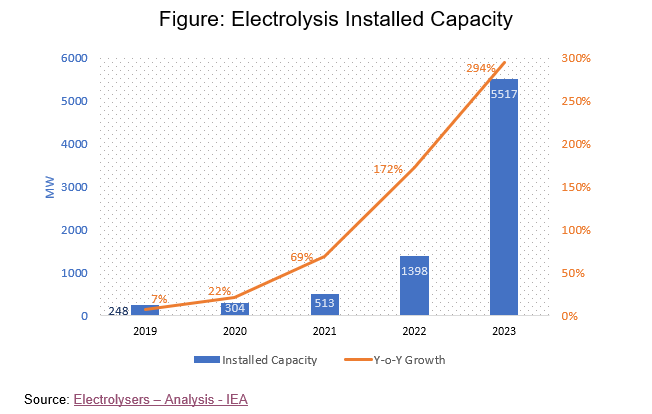Exponential Growth in Electrolysis Plants: Why and What It Will Bring in the Future
Two years back, when the pandemic was gripping the world and strangling many industries, water electrolysis embarked on a journey of exponential growth.

Electrolysis capacity for hydrogen production grew by 22% in 2020 and 69% in 2021. If these growth numbers look impressive to you, hold your breath because they are nothing compared to the growth numbers we will witness for the current and subsequent years and many years to come. Let’s look at the growth trajectory and find out what is happening here. And what it can change in the future. An electrolysis plant separates water (H2O) into hydrogen (H2) and oxygen (O2) with the help of electricity. Basically, it produces hydrogen, with water and electricity as inputs. The process is clean with zero GHG (greenhouse gas) emissions. Produced hydrogen, however, is not entirely emission-free since the input electricity has some emission attached to it when it is sourced from non-renewable sources, like coal or gas power plants. The entire process can be made emission-free by sourcing the required electricity from renewable sources like wind and solar. This way, the produced hydrogen is called green hydrogen and is responsible for the growth we will discuss here. The above figure represents the installed electrolyzer capacity at the end of each year. This clearly suggests a phase of rapid growth, starting somewhere between 2020 and 2021. By the end of 2019, we had 248 MW of installed electrolysis capacity. Two years on, the capacity doubled, reaching 513 MW (by the end of 2021). And by the end of this year, it will more than double in just one year. Considering all the under-construction and planned projects at this point, we can expect it to reach 134-240 GW by 2030. This is, in fact, statistically more than exponential growth. So, what happened suddenly that led to this phenomenal growth? Many industries require hydrogen, and 80% of the hydrogen required (in 2020) is produced from fossil fuels. Hydrogen, if produced from renewable sources, can not only reduce the carbon emission from its existing applications but can also be produced in excess to utilize as fuel for fuel cell applications like vehicles, spacecraft, and more. Among industries where it is used but mainly refining, chemical, and iron, it is crucial for countries to achieve their net zero emission goals. With the help of an electrolysis plant and electricity from a renewable source, it can be a feasible and convenient solution to decarbonize hydrogen production in those industries. The only roadblock is cost since the produced green hydrogen is more expensive than hydrogen from fossil sources, like natural gas. Green hydrogen has two main costs component — electricity and capital costs. Electricity, with more than 50% share, is the main cost contributor. Recently, the reduction in renewable energy costs played a crucial role here. It reduced the price gap between green hydrogen from electrolysis and hydrogen from fossil sources. The other cost component, i.e., capital cost, is mainly an electrolyzer cost. This is expected to come down eventually as more projects lead to more electrolyzer production. Green hydrogen is still more expensive than its fossil counterparts. But the renewable energy cost reduction and future promise of capital cost reduction gave confidence to the industry and policymakers, who then helped to fill the gap. In response, where we had only five countries announced their hydrogen strategies by 2019, more than 20 joined the club in the next two years (IRNEA). They prepared their hydrogen road maps and introduced policies favoring green hydrogen electrolysis projects. Out of all recently completed and upcoming water electrolysis projects during 2020 and 2030, around 95% source electricity either from dedicated renewable sources or excess renewable from the grid, according to Hydrogen Projects Database. Green hydrogen can be a road map for fuel cell applications like vehicles and aircraft. Fuel cells are the opposite of electrolysis, consume hydrogen as fuel and generate electricity with zero GHG emission. We have a small fleet of fuel cell commercial vehicles on the road today, but with most of the hydrogen from fossil sources, it doesn’t fulfill the purpose of net zero emission. Once we have economic sources of green hydrogen, it can pave the way for the rapid commercialization of fuel cell vehicles. Hydrogen fuel cell vehicles offer some advantages over their green alternative, electric vehicles. Both are emission-free and provide a way to achieve net zero emissions. The former offers better ranges in the distance covered and significantly lower refueling time. This makes fuel cells a preferred green choice of commercial transportation where both range and refueling time are crucial to operational success. Two things are expected in the future, massive electrolysis projects and a reduction in green hydrogen prices. This can facilitate green hydrogen production as fuel. But it cannot be accomplished without the participation of hydrogen infrastructure, mainly storage and transportation and fuel cell. If green hydrogen finds a way to transportation, we will see rapid growth in hydrogen infrastructure and fuel cell markets too. If you would like to explore this topic in more depth, please refer to the following resources: BCC Research provides market research with a boutique touch and a depth of expertise in a variety of markets. Dedicated to serving the academic community, corporate professionals and innovation teams, we provide market intel covering 25 industries across verticals in life science, environment/sustainability, materials, sensors, and commerce. About the Author: Anand Dubey is an Associate Director at BCC Research, where he focuses on strategy & insights, thought leadership, market research, and data analysis. Before moving into a management role, he earned an MBA, served as an industry analyst for more than a decade, and wrote a wide variety of market research reports. Two years back, when the pandemic was gripping the world and strangling many industries, water electrolysis embarked on a journey of exponential growth.
Two years back, when the pandemic was gripping the world and strangling many industries, water electrolysis embarked on a journey of exponential growth. Growth in Electrolysis Capacity
Why So Much Growth
A Convenient Way to Reach Closer to Net Zero Emission
Cost Reduction
Future Impact
Market Research Reports
About BCC Research

 Aliver
Aliver 












![3 Instagram Video Formats You Should Leverage in 2022 [Data from 500+ Marketers]](https://blog.hubspot.com/hubfs/video-formats.jpg#keepProtocol)












![How To Host Or Migrate A Website In 2025: Factors That May Break Rankings [+ Checklist] via @sejournal, @inmotionhosting](https://www.searchenginejournal.com/wp-content/uploads/2025/05/featured-508.png)






